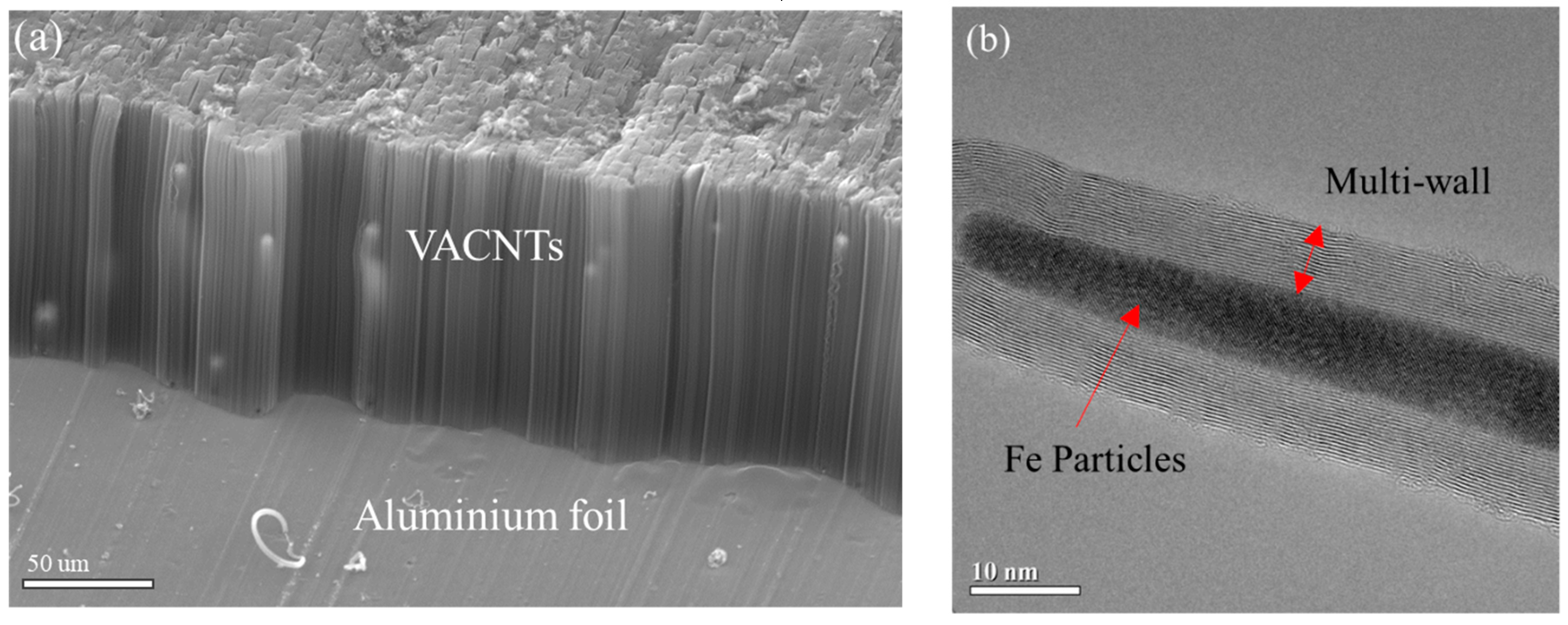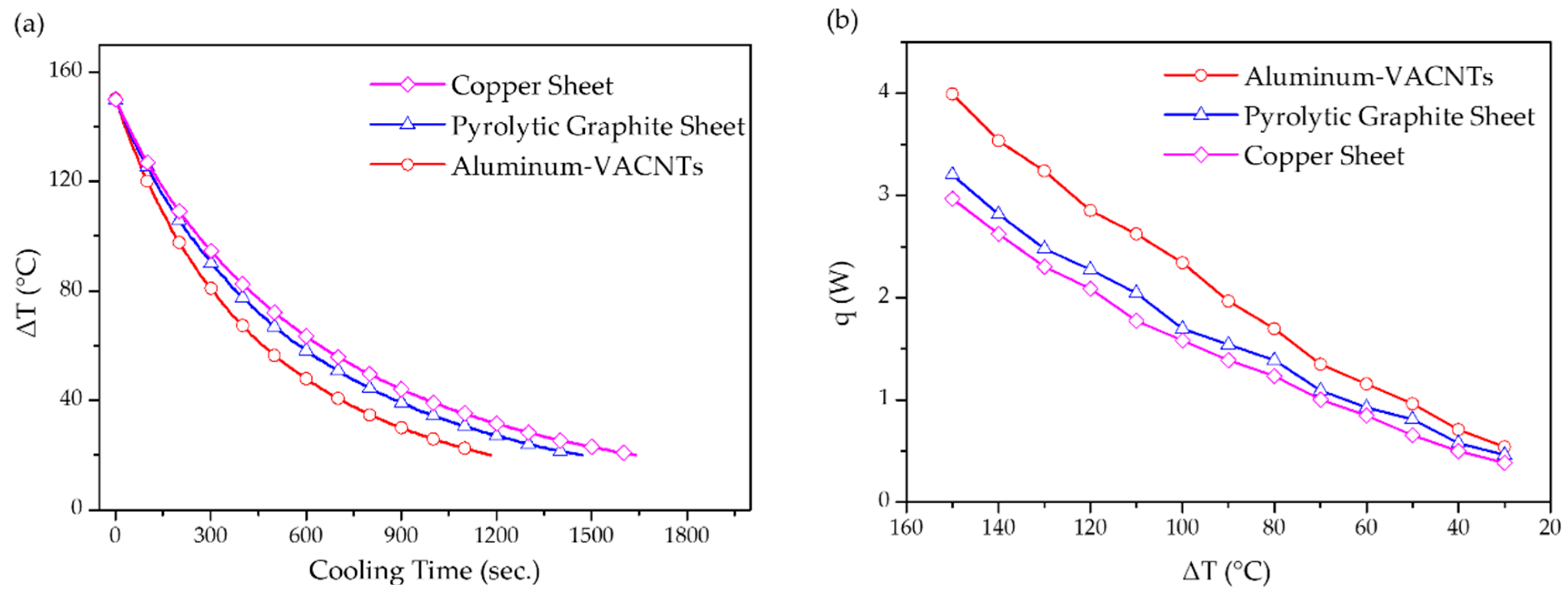Applying Aluminum–Vertically-Aligned Carbon Nanotube Forests Composites for Heat Dissipation
Abstract
:1. Introduction
2. Materials and Methods
2.1. Aluminum–VACNTs Composites Synthesis
2.2. Heat Dissipation Setup
3. Results and Discussions
4. Conclusions
Author Contributions
Funding
Conflicts of Interest
References
- Davis, J.A.; Venkatesan, R.; Kaloyeros, A.; Beylansky, M.; Souri, S.J.; Banerjee, K.; Saraswat, K.C.; Rahman, A.; Reif, R.; Meindl, J.D. Interconnect limits on gigascale integration (GSI) in the 21st century. Proc. IEEE 2001, 89, 305–324. [Google Scholar] [CrossRef] [Green Version]
- Meindl, J.D. Interconnect opportunities for gigascale integration. IEEE Micro 2003, 23, 28–35. [Google Scholar] [CrossRef] [Green Version]
- Koo, J.-M.; Im, S.; Jiang, L.; Goodson, K.E. Integrated Microchannel Cooling for Three-Dimensional Electronic Circuit Architectures. J. Heat Transf. 2005, 127, 49–58. [Google Scholar] [CrossRef]
- Dang, B.; Bakir, M.S.; Sekar, D.C.; King, C.R., Jr.; Meindl, J.D. Integrated Microfluidic Cooling and Interconnects for 2D and 3D Chips. IEEE Trans. Adv. Packag. 2010, 33, 79–87. [Google Scholar] [CrossRef]
- Cola, B.A.; Xu, J.; Cheng, C.R.; Xu, X.F.; Fisher, T.S.; Hu, H.P. Photoacoustic characterization of carbon nanotube array thermal interfaces. J. Appl. Phys. 2007, 101, 054313. [Google Scholar] [CrossRef]
- Cola, B.A.; Xu, X.; Fisher, T.S. Increased real contact in thermal interfaces: A carbon nanotube/foil material. Appl. Phys. Lett. 2007, 90, 093513. [Google Scholar] [CrossRef]
- Iijima, S. Helical microtubules of graphitic carbon. Nature 1991, 354, 56–58. [Google Scholar] [CrossRef]
- Dresselhaus, M.S.; Dresselhaus, G.; Jorio, A. Unusual properties and structure of carbon nanotubes. Annu. Rev. Mater. Res. 2004, 34, 247–278. [Google Scholar] [CrossRef]
- Kim, P.; Shi, L.; Majumdar, A.; McEuen, P.L. Thermal Transport Measurements of Individual Multiwalled Nanotubes. Phys. Rev. Lett. 2001, 87, 215502. [Google Scholar] [CrossRef] [PubMed] [Green Version]
- Pop, E.; Mann, D.; Wang, Q.; Goodson, K.; Dai, H. Thermal Conductance of an Individual Single-Wall Carbon Nanotube above Room Temperature. Nano Lett. 2006, 6, 96–100. [Google Scholar] [CrossRef] [Green Version]
- Balandin, A.A. Thermal properties of graphene and nanostructured carbon materials. Nat. Mater. 2011, 10, 569. [Google Scholar] [CrossRef]
- Harish, S.; Ishikawa, K.; Einarsson, E.; Aikawa, S.; Chiashi, S.; Shiomi, J.; Maruyama, S. Enhanced thermal conductivity of ethylene glycol with single-walled carbon nanotube inclusions. Int. J. Heat Mass Transf. 2012, 55, 3885–3890. [Google Scholar] [CrossRef]
- Shahil, K.M.F.; Balandin, A.A. Thermal properties of graphene and multilayer graphene: Applications in thermal interface materials. Solid State Commun. 2012, 152, 1331–1340. [Google Scholar] [CrossRef]
- Marconnet, A.M.; Panzer, M.A.; Goodson, K.E. Thermal conduction phenomena in carbon nanotubes and related nanostructured materials. Rev. Mod. Phys. 2013, 85, 1295–1326. [Google Scholar] [CrossRef]
- Qiu, L.; Wang, X.; Su, G.; Tang, D.; Zheng, X.; Zhu, J.; Wang, Z.; Norris, P.M.; Bradford, P.D.; Zhu, Y. Remarkably enhanced thermal transport based on a flexible horizontally-aligned carbon nanotube array film. Sci. Rep. 2016, 6, 21014. [Google Scholar] [CrossRef] [Green Version]
- Pei, Y.; Zhong, H.; Wang, M.; Zhang, P.; Zhao, Y. Effect of Contact Pressure on the Performance of Carbon Nanotube Arrays Thermal Interface Material. Nanomaterials 2018, 8, 732. [Google Scholar] [CrossRef] [PubMed]
- Hone, J.; Llaguno, M.; Nemes, N.; Johnson, A.T.C.; Fischer, J.E.; Walters, D.A.; Casavant, M.; Schmidt, J.; Smalley, R.E. Electrical and Thermal Transport Properties of Magnetically Aligned Single-Wall Carbon Nanotube Films. Appl. Phys. Lett. 2000, 77, 666–668. [Google Scholar] [CrossRef]
- Bigg, D.M. Thermal-Conductivity of Heterophase Polymer Compositions. Adv. Polym. Sci. 1995, 119, 1–30. [Google Scholar]
- Deng, F.; Zheng, Q.S.; Wang, L.F.; Nan, C.W. Effects of anisotropy, aspect ratio, and nonstraightness of carbon nanotubes on thermal conductivity of carbon nanotube composites. Appl. Phys. Lett. 2007, 90, 021914. [Google Scholar] [CrossRef]
- Shenogin, S.; Xue, L.P.; Ozisik, R.; Keblinski, P.; Cahill, D.G. Role of thermal boundary resistance on the heat flow in carbon-nanotube composites. J. Appl. Phys. 2004, 95, 8136–8144. [Google Scholar] [CrossRef]
- Shenogina, N.; Shenogin, S.; Xue, L.; Keblinski, P. On the lack of thermal percolation in carbon nanotube composites. Appl. Phys. Lett. 2005, 87, 133106. [Google Scholar] [CrossRef]
- Zeng, J.; Fu, R.L.; Agathopoulos, S.; Zhang, S.D.; Song, X.F.; He, H. Numerical Simulation of Thermal Conductivity of Particle Filled Epoxy Composites. J. Electron. Packag. 2009, 131, 041006. [Google Scholar] [CrossRef]
- Zhou, H.; Zhang, S.; Yang, M. The effect of heat-transfer passages on the effective thermal conductivity of high filler loading composite materials. Compos. Sci. Technol. 2007, 67, 1035–1040. [Google Scholar] [CrossRef]
- Burg, B.R.; Bianco, V.; Schneider, J.; Poulikakos, D. Electrokinetic framework of dielectrophoretic deposition devices. J. Appl. Phys. 2010, 107, 124308. [Google Scholar] [CrossRef]
- Burg, B.R.; Schneider, J.; Bianco, V.; Schirmer, N.C.; Poulikakos, D. Selective Parallel Integration of Individual Metallic Single-Walled Carbon Nanotubes from Heterogeneous Solutions. Langmuir 2010, 26, 10419–10424. [Google Scholar] [CrossRef]
- Holman, J.P. Heat Transfer, 4th ed.; McGraw-Hill: New York, NY, USA, 1976; pp. 97–102. [Google Scholar]
- Kuo, C.H.; Huang, H.M. Responses and thermal conductivity measurements of multi-wall carbon nanotube (MWNT)/epoxy composites. J. Anal. Calorim. 2011, 103, 533–542. [Google Scholar] [CrossRef]
- Lukes, J.R.; Zhong, H.L. Thermal conductivity of individual single-wall carbon nanotubes. J. Heat Trans. Trans. ASME 2007, 129, 705–716. [Google Scholar] [CrossRef]
- Sun, K.; Stroscio, M.A.; Dutta, M. Thermal conductivity of carbon nanotubes. J. Appl. Phys. 2009, 105, 074316. [Google Scholar] [CrossRef]
- Lindsay, L.; Broido, D.A.; Mingo, N. Flexural phonons and thermal transport in graphene. Phys. Rev. B 2010, 82, 115427. [Google Scholar] [CrossRef]
- Yang, Z.-P.; Ci, L.; Bur, J.A.; Lin, S.-Y.; Ajayan, P.M. Experimental Observation of an Extremely Dark Material Made by a Low-Density Nanotube Array. Nano Lett. 2008, 8, 446–451. [Google Scholar] [CrossRef]
- Mizuno, K.; Ishii, J.; Kishida, H.; Hayamizu, Y.; Yasuda, S.; Futaba, D.N.; Yumura, M.; Hata, K. A black body absorber from vertically aligned single-walled carbon nanotubes. Proc. Natl. Acad. Sci. USA 2009, 106, 6044–6047. [Google Scholar] [CrossRef] [PubMed] [Green Version]





© 2019 by the authors. Licensee MDPI, Basel, Switzerland. This article is an open access article distributed under the terms and conditions of the Creative Commons Attribution (CC BY) license (http://creativecommons.org/licenses/by/4.0/).
Share and Cite
Li, Y.-R.; Su, C.-C.; Chang, S.-H. Applying Aluminum–Vertically-Aligned Carbon Nanotube Forests Composites for Heat Dissipation. Nanomaterials 2019, 9, 758. https://doi.org/10.3390/nano9050758
Li Y-R, Su C-C, Chang S-H. Applying Aluminum–Vertically-Aligned Carbon Nanotube Forests Composites for Heat Dissipation. Nanomaterials. 2019; 9(5):758. https://doi.org/10.3390/nano9050758
Chicago/Turabian StyleLi, Yan-Rui, Chih-Chung Su, and Shuo-Hung Chang. 2019. "Applying Aluminum–Vertically-Aligned Carbon Nanotube Forests Composites for Heat Dissipation" Nanomaterials 9, no. 5: 758. https://doi.org/10.3390/nano9050758



